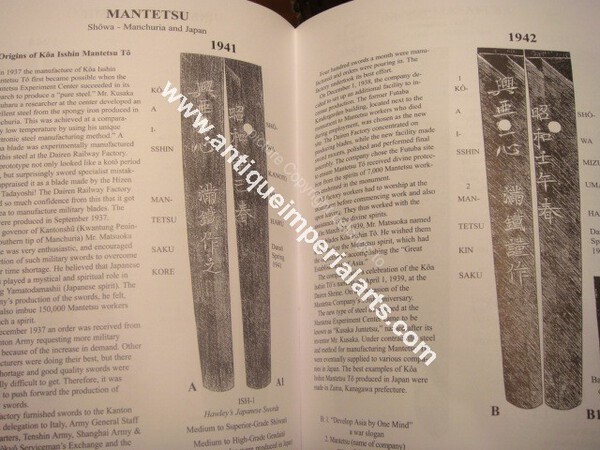-
Posts
2,391 -
Joined
-
Last visited
-
Days Won
35
Content Type
Profiles
Forums
Events
Store
Downloads
Gallery
Posts posted by 16k
-
-
Thanks Brian,
I’d actually seen it and if I can’t find a better price or a seller in Europe (last book I got from Grey, the customs hit me with another $30), I will certainly contact this seller. Thanks again for the link, at least I’ll find it easily now.
-
John posted most (more?)of what I was going to write, so no need to add more. I too do believe it was a katate uchi rather than an o Wakizashi.
The sugata is consistent with the time period so I tend to believe it is shoshin. If you were to fake a kiyomitsu, my gut feeling is you’d write Bizen instead of Boshu as it is more prestigious. Agree also on the tsuka not being original. Much too long for a katate uchi. Then again, I don’t believe many koshirae from the time has survived, so your mountings are probably late Edo period (19th century probably).
Worst case scenario, it was remounted by the seller or a previous one. No big deal anyway as it looks nice and the blade is the part that matters most.
-
Well, it’s sold out on Grey’s site. I’ve found one for $120 on the web, but the site looked fishy. eBay has it for $350. Too much for me at the moment. I’ll wait a little and if I can’t find it, I’ll post in the WTB section. Anyway, looking for this and Ise no toko, so I’ll post a WTB thread at some point.
Thanks again for the pics.

-
Hi Stephen,
This is hard to say without seeing more of the blade (whole sugata, Hada and Hamon close ups) as the fittings can easily be changed over time.
General saying is Bishu instead of Bizen means the sword is lower quality, but since it is far from being a universal truth, I encourage you to post more pictures for more experienced people than me.
-
Thanks Stephen,
This is really interesting. I’ve searched the web for the book, but have only found high prices for it, prices that I can’t manage this month, but now it sure is on my need/want list!
-
That’s great, Stephen, thanks.
Are there other pages about Mantetsu after these? What strikes me is that seems to be almost word for word what Ohmura wrote, only in good English, so I was wondering if there were more as Ohmura can sometimes be a chore to decipher.
-
Thanks. Anyone has a clear picture of those pages?
-
-
Dunno about the tsuka, but I really like the blade. Nice Hada and Hamon.
-
If only I could, Jean, if only...
-
Jean, every time I see this bumped up, a feel a tinge of pain in my heart...
-
 1
1
-
-
Looks like a very good start. I still have to try that one day, though I think a photograph isn’t the best source as you can’t really be sure what is a reflection or an activity. But that looks great, really
-
 1
1
-
-
Love Spider Churchill! Better than Spider-man!
-
What a beautiful piece! Way out of my price range but gorgeous to behold! Congrats to any prospective buyer!
-
I don’t have a regular schedule when it comes to clean/oil blades. Where I live, I guess I could leave my blades without oiling them for years, maybe a lifetime without risks. But I clean them every so often just in case.
-
 1
1
-
-
I needed a couple last year, Identified the thread as 1/8 BSW from the remaining screws that were present on the saya and made two new brass screws.
I did no modification of exsisting threads (in either the fitting or saya) so if I'm lucky enough to find some original ones to fit they should simply screw in.
Being a toolmaker by trade it wasn't to difficult, I even marked them up a little so they looked the part after aging.
In the UK there doesn't seem to be a ready supply of junk saya's with fittings or I can't find any under £100+

Mark
You wouldn’t happen to make more, would you? I’m still looking for three of them. I found some that fit, but they aren’t brass.
-
 1
1
-
-
Well, if he has an apprentice, adopted or not, this will be the 25th generation I guess. It is very unlikely, I think, that the 24 previous generation are all direct descendants of Masamune. So I think it’s the teaching that is the descendant, not the person.The 24th generation descendant, Tsunahiro Yamamura, has a company that creates katana, cooking knives, scissors, knives, and so on in Kamakura. But his son, Takamasa Yamamura, decided to become an opera singer, & is now Head Minister at Myohoji Temple (http://honolulumyohoji.org/profile/). I've met him several times when we've trained at the temple.
Do families still adopt to continue the line? Otherwise, so ends 25 generations of sword makers......kinda' sad.
-
Well, didn’t the Japanese consider the 9 months before the birth as the first year? It would explain 80 (Japanese system) and 79 (western system)
-
I was never really sure if that same was celluloid or not, when I took off the Fuchi it looked like real Samegawa.
Actually, John, it’s not surprising asI just noticed it myself yesterday evening. I had taken the sword apart as i wanted to consolidate the cord sarute with Fray Check and upon inserting the Fuchi back i said “wow, first time I see a full wrap”. Then looking closer, I thought it looked suspicious in comparison to other swords I had and checked my resources and the net. It matches other examples I’ve found.
Hi all, about celluloid and same and the reason both exist,,,,
I suddenly remembered a conversation I had with a host family I stayed with in Osaka in 1980. They told me about the final declining years of the war and some comments made within the family that indicated that the war was going (in the words of the Emperor Hirohito in his "surrender" broadcast Aug. 1945) "not necessarily to Japan's advantage". This family had some clever, observant members (botanists, engineers etc) in it and one said to my host "father" in 1944..."have you noticed that we now eat "rubbish" coastal fish these days? We don't get any deep sea tuna or shark etc any more?. The "father" answered "Well that's because the best of the catch are processed and sent to feed the Army overseas". The family member said, "No, it is because we have no deep sea vessels left, not even tuna boats. We only have rowboats who can only fish in shallow coastal waters. Everything of consequence has been sunk by the Americans...this lack of deep sea fish is actually a sign that the front is getting closer...we have only a short time left".
As it turned out he was correct. I wonder therefore, could the appearance of plastic celluloid same be a manifestation of the increasing shortage of deep see fish from which to obtain same skin? (I'm assuming ray-fish are deep sea?). Maybe from mid-1943 onwards it becomes more common because ray skin (even if coastal) same becomes harder to get because of the destruction of even in-shore vessels?
My own example of plastic celluloid same is on a good quality Rinji Seishiki Gunto dated May 1943 (Yamagami Munetoshi - Niigata - RJT blade (probably mounted in Tokyo) . My second sword is late war (good quality fittings) without any same or celluloid (coarse fabric "same"). it is a Rinji Seishiki Gunto with good quality RJT Takayama Kunihide - Kyoto - blade dated Aug. 1944. (maybe mounted in Osaka near my host families home?). I am not sure of the reason for celluloid same on swords, but maybe it was a variation available to tropic area troops and the "rough textile" same was a result of the late-war shortage of same? Just thought I'd mention it.
Regards,
This sounds quite possible as rays are benthic fish. They don’t all need deep water (I don’t know about this particular species) but it sounds right to think that even those living in shallow waters would be the first to go in times of high demand. It may even be that a certain quota had to be reserved for the army, both to eat and use the skin.
-
 1
1
-
-
Okay, necroposting on this but to add to the list. The Mantetsu I recently bought (sa 520, nan, w, Spring 1943, already in Bruce’s database) has a celluloid same too, so climate may have been a factor... of the lack of Same material. Gotta say, though that I noticed this only recently and contrary to my other swords (granted, all of them older), this same has resisted the test of time without a crack.
-
 1
1
-
-
Only 19.5 m? Okay let me count my copper pieces...

-
hello Jussi
here are some interesting information from Tsuruta san about TB 25. he actually sold one from this session.
https://www.aoijapan.com/notice-about-19128-katana-yoshioka-ichimonji/
Maurice
I don’t even want to ask how much such a gem must have cost the buyer...
-
There seems ,s to be at least a discrepancy between the postcard and the list. aka bane is said to have worn a “something Masamune” on the postcard and a mumei sword on the list. So who knows how accurate all these are...
-
I do believe that it’s also a question of age. Even if machine assisted, modern swords are an important part of Japanese sword history, a history that may come to an end more quickly than we think with the lack of apprentices.
I think it’s only a question of time before the rating system is modified to include a section for important, non traditional swords, worthy to be preserved. You can’t just dismiss a whole aspect of sword history like that. They are the victims of laws put in place after the war and which were trying to find a way to preserve a craft and an important aspect of Japanese culture.
But war is over and those swords are beginning to be more than weapons too. They’re becoming antiques and one day will be recognized as such. It’s just a question of time.
-
 4
4
-




Tsuba is missed from 05.April FRA Airport
in General Nihonto Related Discussion
Posted
Glad you finally got it! It was quite a loooooooong delivery, but the important thing is it arrived and nothing was stolen. Happy for you Chris!